August, 2015
Executive and Committee of Management 2016
That time of year again: comes around very quickly. If it applies to you, here is the link to the Nomination form for the 2016 Committee. Phil Taylor is the Returning Officer and his details are on the form. Note: You must get the agreement of the person you nominate to stand for the position. Nominees can only stand for one position: either the Executive or the Committee of Management. If you have any questions please contact the Secretary.
Aviation Museums National Network
This is a body of not-for-profit aviation museums which meets annually to address problems common to their members. The group includes South Australian Aviation Museum, Moorabbin, Darwin, Bull Creek, Queensland Aviation and us, among others. It is thanks to the work done by this group that many museums were given F-11s, bound for the scrap heap, for display. This year the group will meet on 3rd and 4th October at Bull Creek in Perth. Our representative for 2015, will be Vice President Ken Abbott.
Motto
Thank you to all members who participated in our survey about a possible motto for the restoration, printed on the membership renewal form. We had several other options suggested in addition to the ones we presented to you. The winner by an overwhelming majority is: LIBERATOR RELIVES This motto will now be incorporated on our web page, put on stationery and paperwork and used for publicity purposes.
Birthdays
Two of our longest serving members have celebrated birthday milestones in the past couple of weeks: John Temby who served on Committee for most of his time at the restoration and worked on most areas of the plane and………. Nat Eichler, who also has served, and is still serving on Committee. Nat has been Hangar Manager and Assistant Manager for many years and knows just about everything about A72-176. Nat is currently working as a tour guide and gives visitors a memorable experience. Happy birthday to both of them.
Hangar Update
Engine Runs
These have been halted temporarily. The propeller on the test rig is made from wood and it showed signs of de-lamination. It has been sent to Safe-Air for inspection and any necessary repairs. This work is now completed and the propeller should be back in the hangar soon. Engine runs are a popular drawcard so we’ll be happy to have a fully inspected functioning propeller.
Charles Cull, our resident radio expert, has recommissioned the mechanics of a WW2 radio, part number SCR 522 (TR 5043), demonstrating the complexities of electrical mechanical engineering of a non transistorised piece of military hardware.
Our group of young men working on Sundays under the supervision of Committee member John Keevins, have qualified through Nick Knight, to work on the Boomerang. They are being kept busy on that, on the Oxford and on being tour guides: all doing a great job, The Boomerang is in the process of having the engine nose cowling trial fitted and repaired.
After seeing information about our pop-up display on the repatriation of POWs on the web, Mr Boom, from the Netherlands, contacted us. His grandfather’s wife and his mother had both been interned during WW2 for three years by the Japanese. After the war they were repatriated to Melbourne. He was seeking information about that repatriation but was finding it difficult to find any facts. Dave Miller was able to offer some information through the booklet we printed about the exhibition. The repatriation had been a rapid affair and not well documented so finding details is difficult. As well as the booklet Dave was able to send a picture of the Dutch Embassy in St Kilda Rd. Mr Boom was very pleased with the response to his request.
We also sent a copy of the booklet to the National War Museum in Canberra as we felt it added so much to the national record. The NWM has now requested that we transfer to them the right to place this booklet in the national archives.
Work for the Dole
We have been approached by groups engaged in finding meaningful employment for participants in this programme. It is difficult to find placement for all who need the work so we have agreed to take part in the programme. We shall have some say in the selection of workers. One of our members is qualified to oversee the working group so he will take on that role. We decided that it wasn’t practicable to have a large group working in the hangar so are now compiling a list of possible tasks outside the hangar. Once this is completed and agreed to by Committee the list will be sent to the participating agencies and a crew selected to complete the work.
Advertising Signs
As visitors to the hangar will know, we ask them to give us a reason for their visit. These answers are analysed and the information kept as a valuable record: to aid in our planning; to use in grant applications and to assist in display ideas. The numbers are sent to Committee members each month. Categories include: response to media and web information, the sign outside the hangar, personal recommendations, local residents, people making return visits, engine runs, Liberator members, groups from clubs (Probus, car groups, RSL, etc.), response to displays away from the hangar and recommendations from Pt Cook Museum and local Information Centres. Consistently a large number of visitors tell us they saw our sign and decided to come in. We also score highly on return visitors: better than most museums. Club visits are also very important To maximise the response to the sign we have decided to design a new one, hopefully more eye-catching and informative. The word “aviation” will be included as B-24 Liberator by itself doesn’t necessarily let people unfamiliar with the aircraft, know what we are doing inside the big green shed.
Inverleigh RSL
Members from the Inverleigh RSL attended the hangar on Sunday 2nd August. They had a BBQ lunch and a tour of the hangar then loaded up the donated an undercarriage leg and wheel to take back to Inverleigh. They’ll invite hangar crew members to Inverleigh to see the leg as a display outside their club as soon as it is fixed in position. The RSL members were very pleased with the donation. It will look good beside the Navy and Army artefacts.
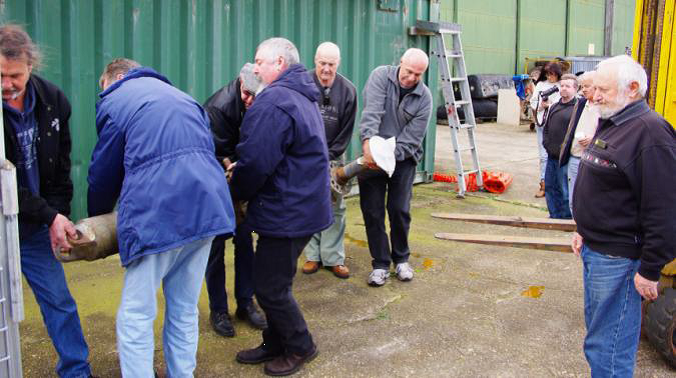
It's big and heavy ...
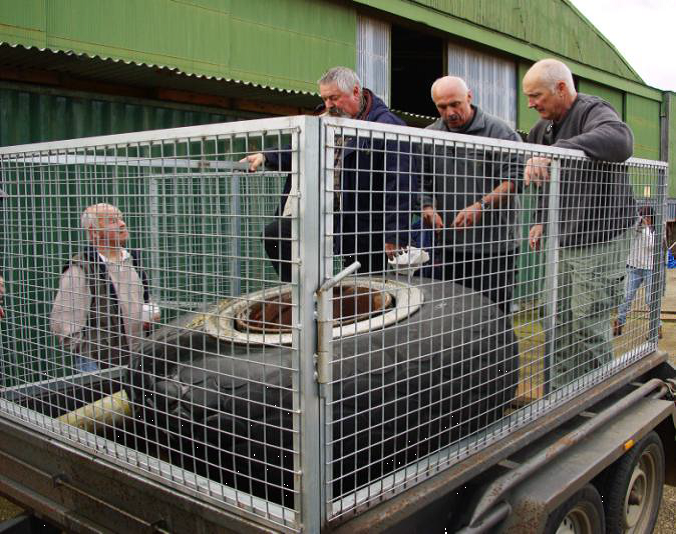
but ..., it fits in the trailer! Now, to get it home.
The Oxford
Editor of the Goldsmith Gazette (Brian Smith) recently did a story on our Oxford replica. He has generously allowed us to feature parts of it in our newsletter. Thanks Brian………. The other plane that shared the WAGS training at Ballarat was the twin engine Airspeed Oxford. In many ways this was similar to the Anson in that it used similar Armstrong Siddeley Cheetah engines. A big difference was the all timber glued frame, which prohibited it from service outside the Air Force, which in turn meant that they had a very poor survival rate, which in turn means that the only way to restore one is to build an airframe and wings from scratch, which is a daunting task. As fortune has it one team has such a project well under way. This team is part of the B-24 group at Werribee between Melbourne and Geelong in Victoria.
The Oxford Project at B-24 Liberator Memorial Australia is managed by two teams:
The Engine Team is restoring two Armstrong Siddeley Cheetah 10 engines to operating condition. Rebuilding these engines is a major task as these engines have been out of service since 1950 or earlier, and many have lain outside, or tucked away in the back of sheds where they can easily be damaged. parts are mixed and matched, and on occasions unused parts can be sourced from other collections around the country. The pristine appearance of an assembled engine gives no idea of the time and effort that have been spent by the people involved.
The Airframe and Wings Team have a major project in their hands. Apart from the metal attachment brackets the entire monocoque frame and wings are made of glued and tacked timber and plywood. To add to the complexity there are very few duplicated items or sections. Fortunately reduced scale drawings were available for most sections which are sufficient to allow the missing sections to be interpolated and redrawn. The central box section of the cantilever wing is the mainframe that attaches to all the major elements of the plane. The airframe is attached over it, the wings are attached to the outer ends and the engines and landing wheels are attached to the front at each end. The leading and trailing wing edges are attached to the front and rear of the box. The MK 1 Oxfords were fitted with a single .303 machine gun in an Armstrong Whitworth Turret behind the cabin. The Mk 2 did not have the turret and was not used for gunnery training. The cabin could be arranged for 2 pilots or for a single pilot and a bomb aimer lying prone in the nose.
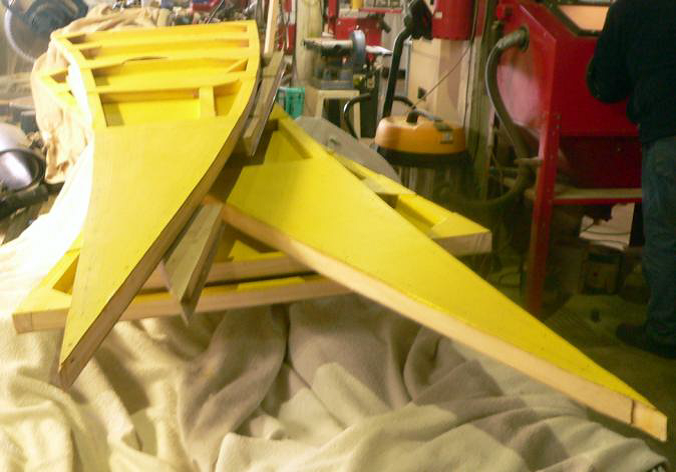
The Oxford box trailing edge.
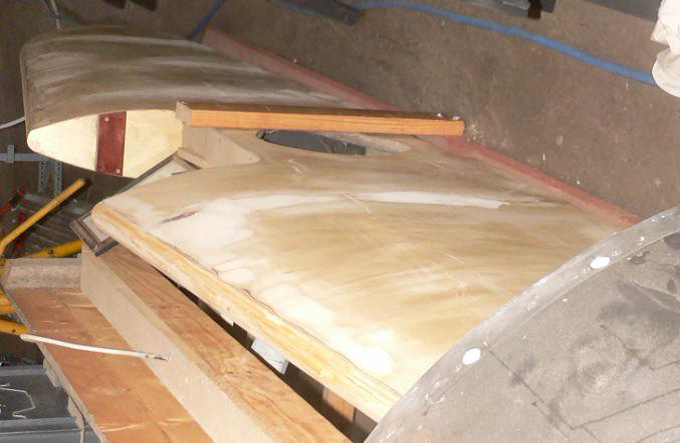
Oxford tailplane.
B-24 Restoration (John Morrissy)
The restoration has reached a stage where we are fitting out the systems that make the aircraft functional. The work now being carried out is not as obvious as work on the airframe but it is essential that the restored aircraft has functioning systems which would meet the standard of limited operational aircraft.
Work on refurbishing the airframe is nearly complete. Roger’s team has been fitting the wing to the fuselage fairings. Small in-fill panels had to be fitted so it has been necessary to install wing trailing edge sections to these small panels. The starboard side is finished and work has now started on the port side. To complete the fairing work the saddle section over the wing will be installed.
Work is progressing on making nacelle cowling panels for the rear section of Number 4 engine. Because the outboard engine cowlings have a different profile to the inboard it has been necessary to re-make some nacelle rings. The cowling panels are fixed to these rings.
The components for aileron and flap controls, pulley brackets and fairleads have been made or restored and installed on the rear wing spar. These components have yet to be fitted inside the fuselage. They’ll be fitted there after the wing fuselage fairings are finished.
The electrical work has focused on instrumentation and controls for engines. Ted and his crew have painstakingly marked individual wires then assembled them in looms with plugs at either end. These are now being installed in the aircraft. Fuse boxes, power supply buses and terminal panels have also been fitted. Jim has recommenced the work on the rear turret started by Ron Taaffe. He is completing the installation of the Perspex window sections.
Leyburn Memorial
This was unveiled at Leyburn in Queensland on Saturday 15th August. It is a memorial in honour of 200 Flight and Z Force. The Liberators of 200 Flight flew Z Force members out of the Leyburn strip during WW2. Their story is a fascinating one. Ian Waters, part of the team who organised the memorial, sent this report: The ceremony went very well with good numbers in attendance including serving Defence Force officers. the District Police Inspector, Mayor of the Southern Downs Regional Council and a councillor and staff member from Toowoomba Regional Council. The stars of the event of course were the two WW2 RAAF Leyburn veterans, Ian Lang and Jim Banks. The families of 3 other veterans were also in attendance. Ian Lang, Patron of the Leyburn RSL, performed the unveiling. Along with several others I was invited to address the gathering and I shall treasure the experience for life.
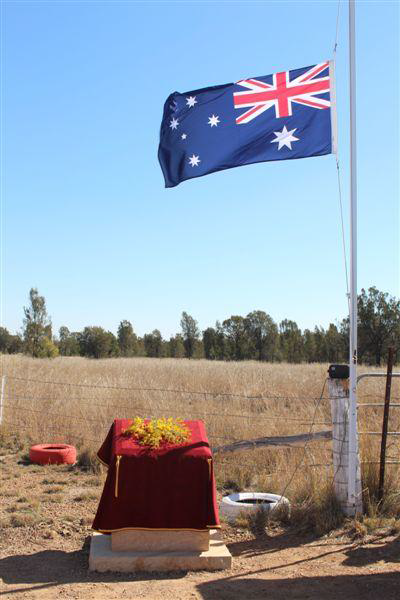
Late News: The restoration has been placed on the Victorian War Heritage Trail List; which was listed by the Dept. of Premier and Cabinet ... 100 Places for 100 Years.




